Assignment 4
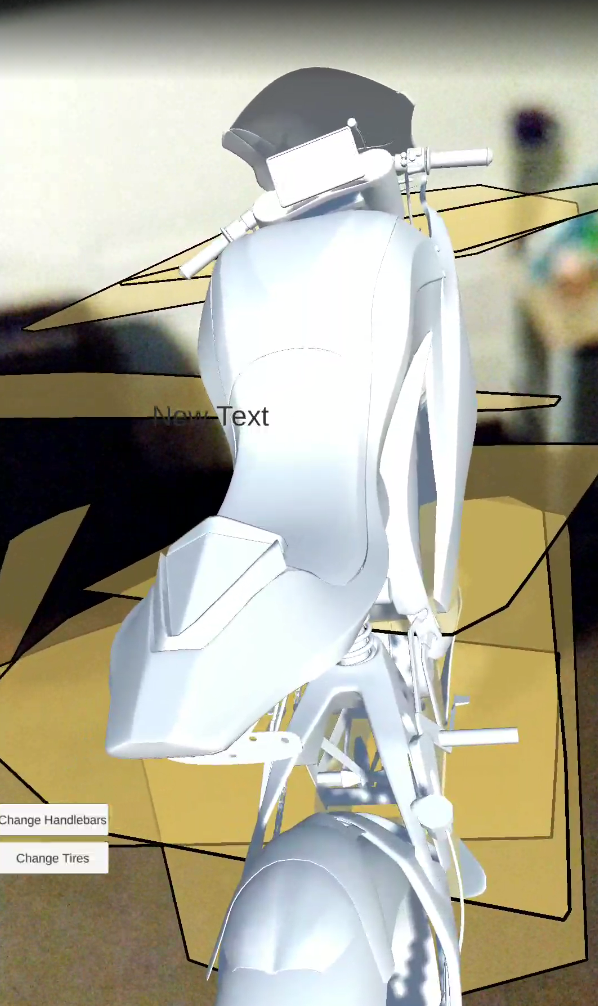
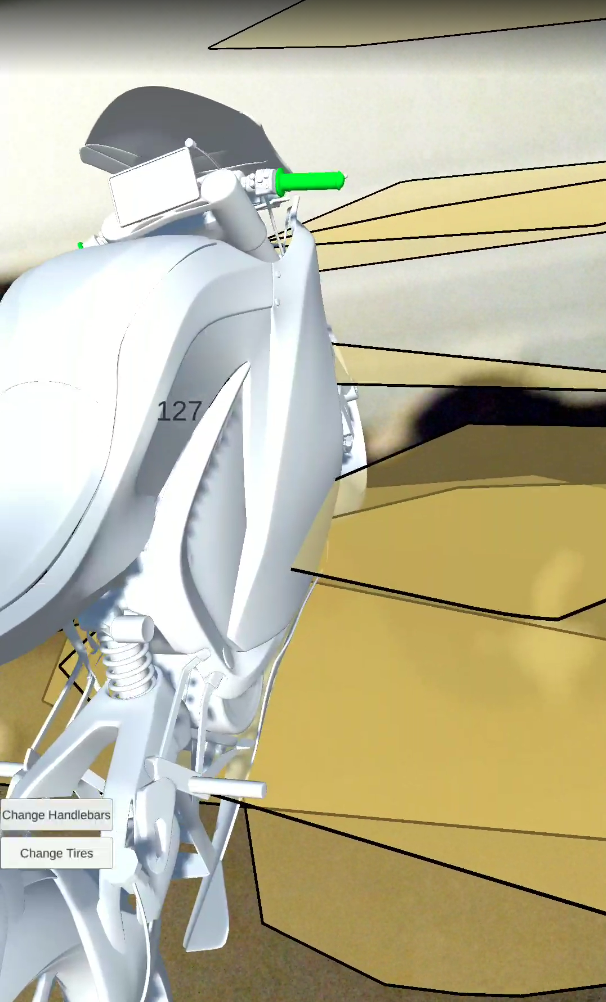

Overview
Imagine you want to purchase a new motorcycle, you visit the dealer, but they don’t have the model in stock for you to be able to view, how do you get a good feeling for the motorcycle and decide if you want to purchase?
This application aims to solve this situation, by using augmented reality to show motorcycle models to the customer and allow them to customise the model to their liking.
Description of the Application
Consider a scenario where you want to go to a motorcycle dealer and buy a new bike. A traditional dealer shop would need a large amount of space, to show off all the different bikes and configurations they have available for purchase.
A virtual environment provided through augmented reality allows for this traditional model to be improved on, saving a dealer a large amount of space, and potentially cost of requiring many display bikes. These improvements are realised by allowing virtual models of the various bikes to be represented in augmented reality, instead of having to have the physical bikes on the shop floor. This type of augmented reality solution is referred to as a ‘user-brand’ engagement, where the interaction is between the customer and the product they wish to purchase (Parekh et al., 2020).
Augmented reality in a retail setting is shown to provide positive outcomes both for the customers and retailers, in terms of increases in customer satisfaction and their willingness to purchase (Poushneh and Vasquez-Parraga, 2017).
This application allows a potential buyer to view a wide range of motorcycles in an augmented reality environment, allowing the buyer to customise various options available on these motorcycles. The initial version of this application allows the user to place a motorcycle in augmented reality on a shop floor and lets them customise options. This gives the customer a better sense of what they want to purchase and gives the sales representative a way to easily show the customer how various options on the motorcycle will look and affect the motorcycle.
The application will show high quality motorcycle models through a mobile device interface and will use standard touch controls to interact with the motorcycle and customise the various options that exist. These are options such as changing the colour, seat, hand grips. Further improvements in later versions may also allow changing of exhaust types and wheels.
Once the user is happy with potential choices, the app will allow the bike with its chosen customisation options to be sent to another terminal, to allow for the purchasing process to commence.
Description of the Interface Solution
Using AR in the context of showing a motorcycle is useful because it allows you to see the motorcycle in a realistic setting at scale and enables you to compare it against other motorcycles in the showroom. Using AR for this application makes sense as using a photo of a motorcycle doesn’t convey scale, doesn’t allow to quickly switch between different motorcycle parts or colours, doesn’t allow for viewing from all angles and doesn’t allow a customer to directly engage with a motorcycle that they have invested time into configuring. Additionally, using VR here would not make sense either as deploying a VR environment in the showroom would take up valuable showroom space, VR is expensive to setup in comparison to AR and could be a potential hazard if someone doesn’t use the equipment properly and falls.
Consider the value of having a motorcycle fully configured by a customer that is to scale and visible from all angles. The configured motorcycle’s options could all be sent to a salesman’s terminal and purchased from there. Since a customer has spent some time configuring the motorcycle it could provide more incentive to purchase the motorcycle (Poushneh and Vasquez-Parraga, 2017). Furthermore, since the customer would have seen how the motorcycle looks previously it could reduce the number of upset customers that are not satisfied with their purchases. Another way of reducing dissatisfied customers is being able to change the lighting for the motorcycle so they can see what the motorcycle would look like in different situations. Additionally, if a motorcycle was sold out and a customer wanted to see what it looked like then a full-scale AR version of the motorbike would be a good option to have rather than VR or a book with pictures of the motorcycle.
In summary, using AR in the context of this application could reduce the number of unhappy customers, boost sales, allows for comparisons with other motorcycles, and engages customers in a cost-effective way compared to the other solutions that were mentioned.
Interaction Design
The exact interactions in the application are using dropdown menus to select a motorcycle, using dropdown menus to change colours of motorcycle parts, a button to hide the UI, using dropdown menus to change the motorcycle parts themselves and placing the bike in the scene or showroom. A non-direct interaction is finding a space that ARCore will use to be able to place the bike, it is worth mentioning as this can sometimes be difficult and may need to be tuned in a later version of the application.
The interactions of using the menus to change motorcycle qualities have been implemented this way for ease of use and to put more focus on the motorcycle by using a minimalist aesthetic. Consider if we used many different buttons on the screen of a phone or tablet to change the type of motorcycle, motorcycle parts and colours of parts all at the same time. The screen would be cluttered and crammed with buttons, and this would distract from displaying the bike which is the point of the AR application. Using the menus also allows us to have many different part and colour options for each individual motorcycle and allows for the customisation that was mentioned earlier in “Description of the Application” to be changed in real time.
Consider if we utilised VR for these interactions instead of ARCore. The overall result would be similar to the ARCore solution we came up with except the VR version might be a bit more spaced out and easier to view through the headset. However, the strengths of using AR in the showroom scenario are that AR takes up less overall space, it is cheaper to implement and maintain and the user doesn’t need a headset to operate the application. The user is also able to get a much better image of the size of the bike using AR compared to a VR approach.
Some interactions that were not included in this prototype but will be included in future versions are being able to rotate a selected motorcycle, a button to hide the UI to enable a clearer view of the bike, a menu or button to be able to send a unique motorcycle configuration to a clerk and a menu or button to be able to change lighting settings in the AR environment.
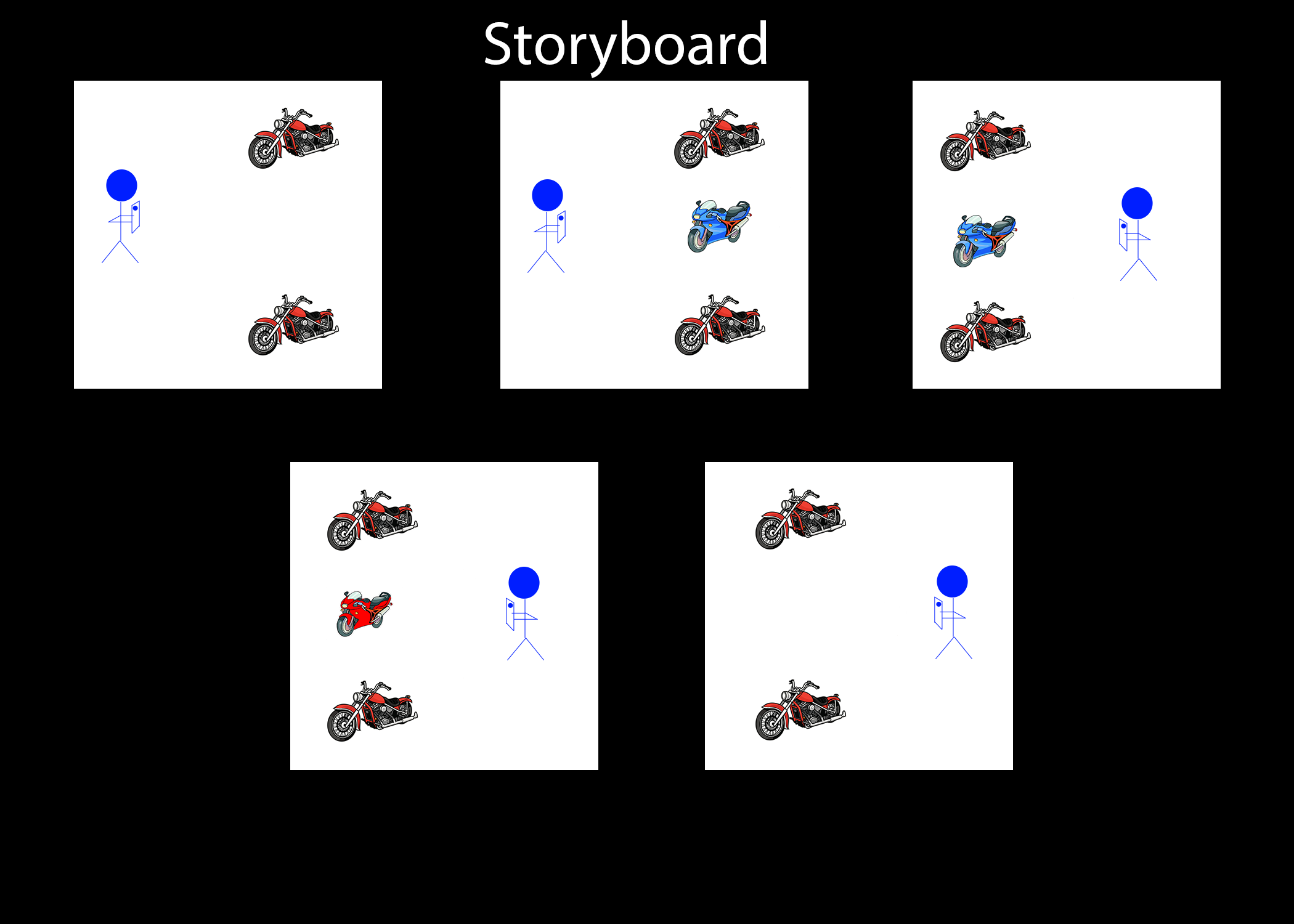
The storyboard illustrates how the application may be used in a showroom. In the top left box, we have a user finding a space for the motorcycle to appear in the showroom. The next box demonstrates that the user has chosen a motorcycle from the menu in the application and placed it in the AR environment through the phone or tablet. The box on the top right shows that the user can manoeuvre around the motorcycle that has been spawned in and can compare it to the other motorcycles in the showroom. The bottom left box is showing a user modifying the colour of the motorcycle and configuring it to their liking. The final box in the bottom right corner is demonstrating that the user is happy with how they have configured their motorcycle and has sent it to a clerk for purchase.
Initial Technical Development
Specific interface technology: AR Core
The app will be run on and developed on a Google Pixel 2 as they are lent by the University. We also wish to use the Pixel 2 due to its depth sensor that should allow for better AR functionality.
Interactions – Planned or Developing:
Within our application, there are many different user interactions and user adjustable options that are being planned and developed.
To customise each part of the bike, there will be drop down menus for each component of the bike that have the ability to change the type of part to a different variant that has a different look or the ability to change the colour of it. This is so a user can have each of the different part variations in different colours as well to match their liking.
The following options are being planned for the application:
- Change colour of bike as a whole
- Change exhaust model
- Change seat model
- Change wheels model
- Change hand grips model
- Exhaust model
- Seat model
- Hand grips model
Below are the corresponding items from above you will also have the ability to change colour of. These choices will be predefined as manufacturers normally only have a select few colour variants.
Additional options in the user interface include the ability to hide the UI so once a user has finished editing the options on their bike, they can get a much clearer view of it without having the bike options clutter the screen of the mobile device.
So far, we have initially developed the ability to show the bike on the screen in the room using ARCore. We have also developed the ability to change the colour of the hand grip and wheel colour. The ability to change the wheel colour is not planned to be in the final version but was put in while we were initially testing how to interact with the bike.
Initial 3D Models
There are currently four 3D models that are being considered for this application, all of which have customisable bodies. At this stage in development, the SPY-HYPERSPORT is the only bike within the program and does not contain any customisations. In the final version of this application there will be multiple models that can be customised.
The first model that was considered for this program was the SPY-HYPERSPORT. The design of this model is fairly advanced and pays high attention to detail. This is observed throughout the whole model, ranging from the wheels to the Navman and the headlights. The most appropriate modifications for this model would involve changing the colour of the bike, altering the position and design of the hand grips and replacing the wheels.

The second model that was considered for this program was the 125CC Naked Motorcycle. This 3D model is based off of a Yamaha YBR 125 and has a detailed motor and large exhaust. The most appropriate modifications for this model would include changing the wheels, replacing the design and size of the handgrips, and altering the colour of the bike.
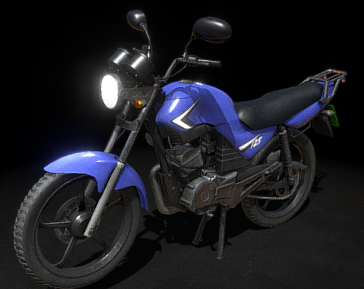
The third model that was considered for this program was the Harley-Davidson Night Rod. This model contains a detailed and compact engine with a large double exhaust. The most appropriate modifications for this model would include the ability to change the seat, adjust and replace the handgrips, and alter the exhaust and the colour of the motorbike.
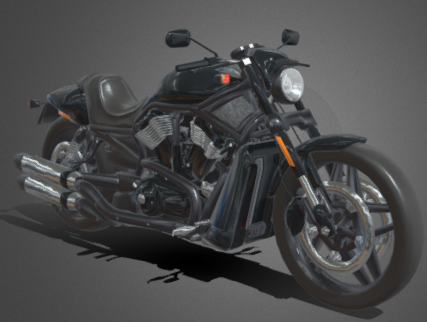
The final model that was considered for this program was the Fancy Orange Motorcycle. This model is fairly compact and consists of a dual exhaust. The most appropriate modifications for this model would include the ability to alter the handgrips and change the colour of the motorbike.
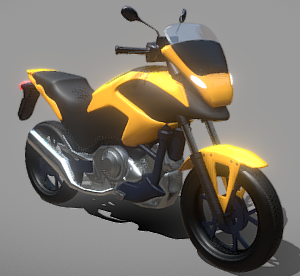
The initial four models that were considered for this application contain a diverse range of designs. This strengthens the intended purpose of this application by displaying a broad range of motorbikes that the customer can view and customise.
Conclusion
Our application is designed using augmented reality and can be used to display motorcycles and allows the user to customise various colours and parts for prospective buyers. It fulfils a need in that it allows buyers to easily view many different motorcycles, without the dealer having to have every possible bike and their various options in stock.
What we currently have implemented is an augmented reality application utilizing ARCore targeting on Android, tested primarily on a Pixel 2 device. So far, this application is functional in that it spawns in a motorbike model with a tap of a detected area and can be observed from all angles. As a proof of concept, we can currently change the colour of the tyres and handgrips, although this will be modified in the final version.
The complete application will then fully implement correct colour change, modification of parts, including exhaust, handgrips and will provide the user with the ability to checkout for purchase. We will also look to implement menus, for ease of use and minimalism to maintain focus on bike and changeable lighting settings for the bike so you can see what it looks like in different lighting situations.
References:
Poushneh, A. and Vasquez-Parraga, A.Z. (2017). Discernible impact of augmented reality on retail customer’s experience, satisfaction and willingness to buy. Journal of Retailing and Consumer Services, [online] 34, p.229. Available at: https://www.academia.edu/31105412/Discernible_impact_of_augmented_reality_on_ret... [Accessed 9 Oct. 2022].
Parekh, P., Patel, S., Patel, N. and Shah, M. (2020). Systematic review and meta-analysis of augmented reality in medicine, retail, and games. Visual Computing for Industry, Biomedicine, and Art, 3(21). https://doi.org/10.1186/s42492-020-00057-7 [Accessed 9 Oct. 2022].
Amvall (2022) SPY-HYPERSPORT, Sketchfab. Available at: https://sketchfab.com/3d-models/spy hypersport-158b48d550144451a59731720f63650a (Accessed: October 6, 2022).
drydoctoregg (2020) 125cc Naked Motorcycle, Sketchfab. Available at: https://sketchfab.com/3d-models/125cc-naked-motorcycle-c8c2a4c00c464c99969b1fc75... (Accessed: October 6, 2022).
e-restrepo1114 (2021) night rod, Sketchfab. Available at: https://sketchfab.com/3d-models/night-rod-e61fc30b0e2d4920bc2ba45127448204 (Accessed: October 6, 2022).
Free Motorcycle Clipart #1302325 (License: Personal Use) (no date) Clipart Library. Available at: http://clipart-library.com/clipart/rTnKRzMac.htm (Accessed: October 6, 2022).
inktycoon (no date) Generic Motorcycle stock illustration, istock. Available at: https://www.istockphoto.com/vector/generic-motorcycle-gm165728272-12919111 (Accessed: October 6, 2022).
Motorcycle Clip Art Motorcycle Clip Art Cartoon Motorcycle - Motorcycle Clip Art (no date) NICEPNG. Available at: https://www.nicepng.com/ourpic/u2w7t4i1q8t4a9o0_motorcycle-clip-art-motorcycle-c... (Accessed: October 6, 2022).
Silas6 (2016) Motorcycle, Sketchfab. Available at: https://sketchfab.com/3d-models/motorcycle-693e83d86e1e4e5b95e4314dbdd95d40 (Accessed: October 6, 2022).
Wood Sign Transparent Background #1188308 (no date) Clipart Library. Available at: http://clipart-library.com/clip-art/139-1391482_cartoon-sign-animation-shoulder-... (Accessed: October 6, 2022).
Get KIT208 Assignment 4 & 5
KIT208 Assignment 4 & 5
| Status | Released |
| Authors | ljpacker, JustinS-H, TheSlavBoi, sam4343 |
More posts
- Assignment 5Oct 28, 2022

Leave a comment
Log in with itch.io to leave a comment.